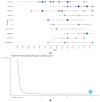Evolution of the Management of Brain Metastases: A Bibliometric Analysis
- PMID: 38067273
- PMCID: PMC10705608
- DOI: 10.3390/cancers15235570
Evolution of the Management of Brain Metastases: A Bibliometric Analysis
Abstract
A systematic review of the published literature was conducted to analyze the management evolution of brain metastases from different cancers. Using the keywords "brain metastasis", "brain metastases", "CNS metastasis", "CNS metastases", "phase III" AND/OR "Randomized Controlled Trial" (RCT), relevant articles were searched for on the SCOPUS database. A total of 1986 articles were retrieved, published over a 45-year period (1977-2022). Relevant articles were defined as clinical studies describing the treatment or prevention of brain metastases from any cancer. Articles on imaging, quality of life, cognitive impairment after treatment, or primary brain tumors were excluded. After a secondary analysis, reviewing the abstracts and/or full texts, 724 articles were found to be relevant. Publications significantly increased in the last 10 years. A total of 252 articles (34.8%) were published in 12 core journals, receiving 50% of the citations. The number of publications in Frontiers in Oncology, BMC Cancer, and Radiotherapy and Oncology have increased considerably over the last few years. There were 111 randomized controlled trials, 128 review articles, and 63 meta-analyses. Most randomized trials reported on brain metastases management from unselected tumors (49), lung cancer (47), or breast cancer (11). In the last 5 years (2017 to 2022), management of brain metastasis has moved on from WBRT, the use of chemotherapy, and radio-sensitization to three directions. First, Radiosurgery or Radiotherapy (SRS/SRT), or hippocampal-sparing WBRT is employed to reduce radiation toxicity. Second, it has moved to the use of novel agents, such as tyrosine kinase inhibitors (TKI) and immune checkpoint inhibitors (ICI) and third, to the use of molecularly directed therapy such as TKIs, in asymptomatic low volume metastasis, obviating the need for WBRT.
Keywords: CNS metastasis; Oman; SRS; Simultaneous Integrated Boost (SIB); Whole Brain Radiotherapy (WBRT); brain metastasis; hippocampal sparing radiotherapy; integrative review; randomized controlled trial.
Conflict of interest statement
The authors declared no conflict of interest.
Figures








Similar articles
-
Management of single brain metastasis: a practice guideline.Curr Oncol. 2007 Aug;14(4):131-43. doi: 10.3747/co.2007.129. Curr Oncol. 2007. PMID: 17710205 Free PMC article.
-
Randomised prospective phase II trial in multiple brain metastases comparing outcomes between hippocampal avoidance whole brain radiotherapy with or without simultaneous integrated boost: HA-SIB-WBRT study protocol.BMC Cancer. 2020 Oct 30;20(1):1045. doi: 10.1186/s12885-020-07565-y. BMC Cancer. 2020. PMID: 33126867 Free PMC article.
-
Medical and health economic assessment of radiosurgery for the treatment of brain metastasis.GMS Health Technol Assess. 2009 Mar 9;5:Doc03. doi: 10.3205/hta000065. GMS Health Technol Assess. 2009. PMID: 21289890 Free PMC article.
-
Optimal management of brainstem metastases: a narrative review.Chin Clin Oncol. 2022 Apr;11(2):15. doi: 10.21037/cco-21-146. Chin Clin Oncol. 2022. PMID: 35534793 Review.
-
Emerging Trends in the Management of Brain Metastases from Non-small Cell Lung Cancer.Curr Oncol Rep. 2018 May 7;20(7):54. doi: 10.1007/s11912-018-0695-9. Curr Oncol Rep. 2018. PMID: 29736685 Review.
Cited by
-
Current perspectives and trends in the treatment of brain arteriovenous malformations: a review and bibliometric analysis.Front Neurol. 2024 Jan 11;14:1327915. doi: 10.3389/fneur.2023.1327915. eCollection 2023. Front Neurol. 2024. PMID: 38274874 Free PMC article.
-
AO Spine Knowledge Forums Promote Collaboration and Elevate the Impact of Research: A Bibliometric Analysis.Global Spine J. 2025 Jun 13:21925682251351012. doi: 10.1177/21925682251351012. Online ahead of print. Global Spine J. 2025. PMID: 40513712 Free PMC article. Review.
-
Brain Metastasis in the Emergency Department: Epidemiology, Presentation, Investigations, and Management.Cancers (Basel). 2024 Jul 19;16(14):2583. doi: 10.3390/cancers16142583. Cancers (Basel). 2024. PMID: 39061222 Free PMC article. Review.
-
Fractionated Stereotactic Intensity-Modulated Radiotherapy for Large Brain Metastases: Comprehensive Analyses of Dose-Volume Predictors of Radiation-Induced Brain Necrosis.Cancers (Basel). 2024 Sep 28;16(19):3327. doi: 10.3390/cancers16193327. Cancers (Basel). 2024. PMID: 39409947 Free PMC article.
-
Characterization of the tumor microenvironment in breast cancer brain metastasis.Heliyon. 2024 Jul 23;10(15):e34876. doi: 10.1016/j.heliyon.2024.e34876. eCollection 2024 Aug 15. Heliyon. 2024. PMID: 39157383 Free PMC article.
References
-
- Black P. Brain metastasis: Current status and recommended guidelines for management. Neurosurgery. 1979;5:617–631. - PubMed
Publication types
LinkOut - more resources
Full Text Sources

